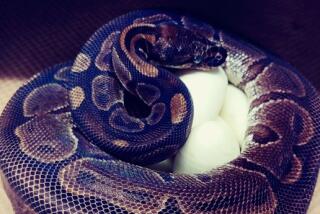Death of Shuttle’s Most Prolific Newt Is ‘Big Loss,’ Scientist Says
- Share via
KENNEDY SPACE CENTER, Fla. — The space shuttle Columbia’s most prolific newt--she had laid about 40 eggs in less than a week in orbit--was found dead Thursday, an apparent victim of stress.
Scientists lost not only the salamander but all of her eggs and 48 other newt eggs that were in the same laboratory tray and were contaminated by the dead animal.
“It’s not a smiling day,” said Japanese project scientist Shunji Nagaoka. “That’s a big loss.”
To add to the problem, one of the three surviving adult female newts has yet to lay an egg. Nagaoka said researchers fear that they may have selected a sterile newt.
Columbia’s two other newts had laid about a dozen eggs in space as of Thursday, six days into the scheduled 14-day mission devoted to research into how organisms reproduce, develop and adapt in space.
The Japanese red-bellied newts were taken last winter from rice paddies in Japan. Female newts hibernate after the fall mating season and store sperm in their bodies for fertilizing their eggs in the spring. Scientists kept the newts refrigerated to prolong hibernation until a few days before Columbia’s launch.
There was one bit of good newt news--scientists announced Thursday that a second newt had been born in space. Both eggs had been laid on Earth before liftoff.
Texas researcher Michael Wiederhold said the dead newt probably succumbed to stress from hormone injections that were administered prior to flight to induce egg-laying, as well as the stress of laying so many eggs. The stress of spaceflight also may have been a factor.
There still are 90 viable, ground-laid newt eggs aboard Columbia.
“You have to remember that in the wild, only a very small number of newt eggs would survive,” said Wiederhold, a researcher at the University of Texas Health Science Center in San Antonio. “Each newt lays 20 to 40, 50 eggs, so obviously if they’d all survive we’d have nothing but newts in the world.”
Wiederhold is studying the development of the gravity-sensing part of newts’ inner ears. Scientists hope the research will help them understand space motion sickness in astronauts.
Also on board are goldfish, guppy-like Japanese Medaka fish and eggs, jellyfish, sea urchins and flies.
More to Read
Sign up for Essential California
The most important California stories and recommendations in your inbox every morning.
You may occasionally receive promotional content from the Los Angeles Times.













